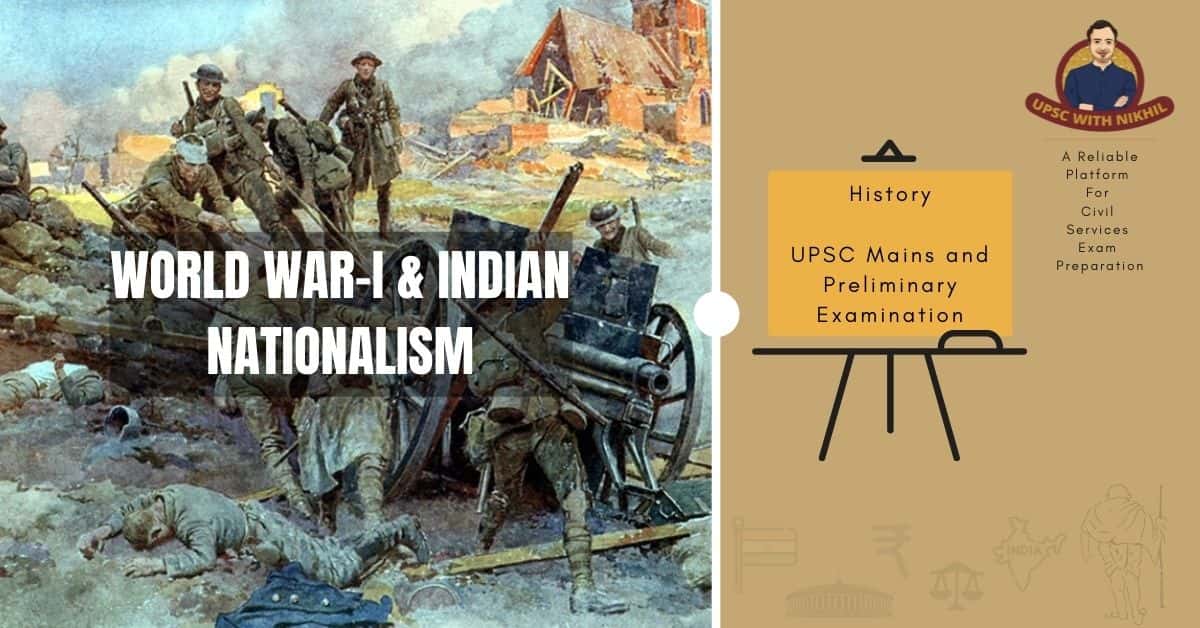World War-i & Indian Nationalism
The outbreak of World War I in 1914 resurrected the nationalist movement, which had been dormant since the heady days of the Swadeshi Movement. The problem for Britain was India's 'opportunity.' The Ghadar revolutionaries in North America and Lokamanya Tilak, Annie Besant, and their Home Rule Leagues in India both took advantage of this opportunity in different ways and with varying degrees of success. The Ghadarites attempted a violent overthrow of British rule, while the Home Rule Leaguers began a nationwide campaign for Home Rule or Swaraj.
INDIAN IMMIGRANTS:
• Since 1904, a steadily increasing number of Punjabi immigrants had settled on the West Coast of North America. Many of them were land-hungry peasants looking for a way to survive in Punjab's densely populated areas, particularly the Jullundur and Hoshiarpur districts.
• Some of them arrived straight from their Punjab villages, while others had previously emigrated to seek work in the Far East, the Malay States, and Fiji.
• Many of them were ex-soldiers whose service in the British Indian Army had taken them to far-flung lands and exposed them to new possibilities. They pawned their belongings, mortgaged or sold their land, and set out for the promised lands, pushed out of their homes by economic hardship and lured by the prospect of building a new and prosperous life for themselves and their kin.

• The welcome that awaited the weary travellers in Canada and the United States, however, was not what they had anticipated.
• Many were turned away, particularly those who arrived straight from their villages and were unfamiliar with Western customs and manners. Those who were allowed to stay faced not only racial prejudice, but also the wrath of the White labour force and unions, who resented the competition they offered.
• Native American labourers organised protests against the Indians' entry, which were backed by politicians looking for votes. Meanwhile, India's Secretary of State had his own reasons for advocating for immigration restrictions. For one thing, he believed that the close familiarity of Indians with Whites that would inevitably occur in America was bad for British prestige; India was held by prestige alone, not by force.
• He was also concerned that the immigrants would become infected with socialist ideas, and that the racial discrimination to which they would inevitably be subjected would fuel nationalist agitation in India.' In 1908, as a result of the combined pressures, Indian immigration into Canada was effectively restricted.
Indian’s activity on foreign land:
a. Tarak Nath Das, an Indian student and one of the first leaders of the Indian community in North America to start a paper called Free Hindustan, realised that while the British government wanted Indians to work as plantation labourers in Fiji, it didn't want them to go to North America where they might be infected by ideas of liberty. In Vancouver he founded the Free Hindustan and adopted a militant nationalist tone.
b. Ramnath Puri, a political exile on the West Coast, issued a Circular-e-Azadi (Circular of Liberty) in 1907, in which he also pledged support to the Swadeshi Movement.
c. G.D. Kumar established a Swadesh Sevak Home in Vancouver, modelled after the India House in London, and began to publish a magazine.
d. United India house: In 1910, Tarak Nath Das and G.D. Kumar, who had been forced out of Vancouver, established the United India House in Seattle, where they lectured to a group of twenty-five Indian labourers every Saturday.
o Here mostly made up of radical nationalist students, formed close ties with the Khalsa Diwan Society, and in 1913 they decided to send a deputation to meet the Colonial Secretary in London as well as the Viceroy and other officials in India.
o They were unable to meet with the Colonial Secretary in London despite waiting a month, but they were able to meet with the Viceroy and Lieutenant Governor of the Punjab in India. But, more importantly, their visit sparked a series of public meetings in Lahore, Ludhiana, Ambala, Ferozepore, Jullundur, Amritsar Lyallpur, Gujranwala, Sialkot, and Simla, where they were greeted with enthusiasm by the press and the general public.


